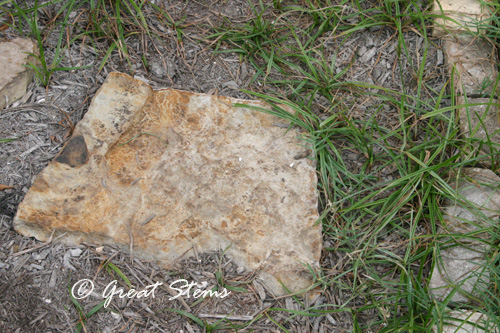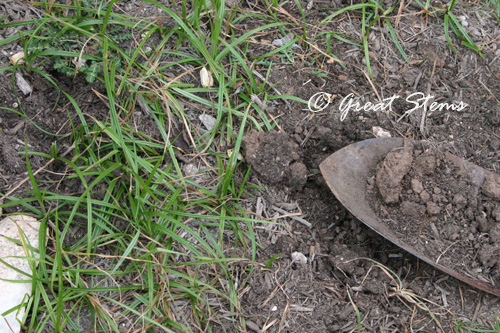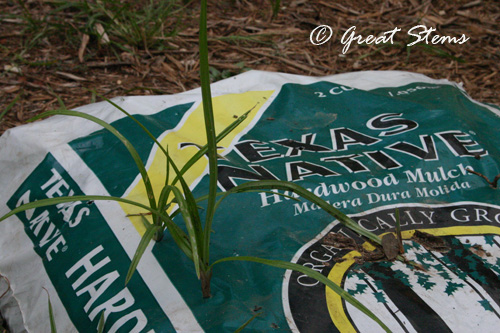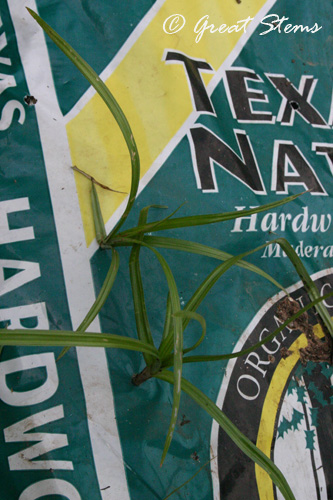Today I rant. I’ve had it. I’ve often suspected that the source of the nut sedge (a.k.a. nutgrass) that came into my yard after I started gardening two years ago was the mulch I placed in my perennial beds to help deal with drought. The nut sedge has become a nightmare and it ties with Bermuda grass as my #1 most hated pest plant in my garden. Right now I’m so fed up it might actually push Bermuda to the full #2 spot.
 Now, I do recognize that the sheer act of prepping soil for a garden leads to ideal nut sedge seed germination conditions, but all I know is that I’d never seen this plant in my yard before I started laying down the mulch.
Now, I do recognize that the sheer act of prepping soil for a garden leads to ideal nut sedge seed germination conditions, but all I know is that I’d never seen this plant in my yard before I started laying down the mulch.
 Well, check out what’s growing from this mulch bag itself. How’s this for proof?
Well, check out what’s growing from this mulch bag itself. How’s this for proof?

 I suppose I could be overreacting. I know that these seeds are everywhere. But I’ve noticed that when I pull out VERY YOUNG sprouts from a freshly mulched garden bed, the roots often don’t extend into the soil, just from the mulch. And I have an area in my garden that I added compost to but never covered with mulch. No nut sedge in that area, just in the mulched areas nearby. Coincidence? I think not.
I suppose I could be overreacting. I know that these seeds are everywhere. But I’ve noticed that when I pull out VERY YOUNG sprouts from a freshly mulched garden bed, the roots often don’t extend into the soil, just from the mulch. And I have an area in my garden that I added compost to but never covered with mulch. No nut sedge in that area, just in the mulched areas nearby. Coincidence? I think not.
So I won’t be buying this bagged mulch anymore. I’ll be finding another mulch, or sticking with tried and true raked leaves. They’re free, anyway.
And of course I still promote the value of mulch in general — in Texas some sort of mulch is necessary to protect your little plants from the heat, and there are many other benefits to mulch.
But no more bagged mulch for me. Anyone else had similar concerns about it?
Ooh, that is bad news. I’ve never had this issue before. Yes, I battle nutsedge, but it pops up worse in my decomposed granite areas than in my mulch. Still, the last photo is pretty damning evidence.
I’m curious about the process they go through in making that mulch — or maybe the large piles collect the seeds (and perhaps other weed seeds) while they sit outside waiting to be bagged. But a few weed seeds wouldn’t be a big deal — tons are another story.
Weeds growing out of a mulch bag? The bag isn’t even open yet!!! Yes, use dry leaves instead. Good things are usually free like the air we breathe in and the sunshine that we enjoy each day.
In the side garden, leaves have always been the only mulch. But now that most of my plants in the main garden are bigger, it will be easier to switch to leaves there, too. A big advantage to hardwood mulch is that it starts out looking so pretty and helps hide the fact that the greenery is small. But it’s time to change.
That’s disconcerting! Especially considering that’s the exact type of mulch I use (when I don’t have leaves handy, of course). Hmm…
Have you had problems with nutgrass, Amy? I’m hoping that it’s really not a major issue with the mulch. Maybe I just got several bags of tainted mulch.
I hate to say it, but bulk mulch can be just as risky, or even riskier. One local provider no longer gets mulch business from me since the last 12 yard load I received yielded several twisted drink cans and about 2 years of Stinkhorn mushrooms. There was an interesting lesson for the kids, yep. I later found out that particular mulch provider charges landscaping companies to come dump their vegetative waste, which they then process into mulch; so much for the playscape “certification” on the mulch I bought.
Now it’s make my own, or stick with mulch from one of my favorite providers, who also make some excellent soils (it’s more than dirt, really).
On the evils of nut sedge: I have a friend who ran a 4 inch thick asphalt road over a patch of the stuff and it grew right through. I think it’s the cockroach of the plant world.
Ugh, Richard, on that bulk mulch. And I totally agree with you about nut sedge being the cockroach.
My first nutsedge arrived in bagged mulch or even bagged compost, I’m convinced. However, I’ve used the brand you show for a couple of years with no problems in my other beds. But, you should definitely let them know about this!
I was thinking about contacting them, Linda, but truth is, there’s unlikely a way to keep mulch seed free. However, I’d like to know whether the seeds are coming in from some of their private drop offs (I just glanced at their website) — perhaps screening that brush better will help. I’ll shoot them an e-mail to see what they say.
Wow, I’d be so mad. I have nutsedge anyway, but to get it from mulch I bought, that’s just wrong.~~Dee
I agree! I did send the company an e-mail today. We’ll see what they have to say about it.
looks like proof to me!!
I wonder if what I have comes from the mulch as well!
I do have a lot of nut sedge in my path. It just bakes right in and is so hard to pull out. I have never thought about how the mulch could be the source….hmmmmm. I have to deal with the Bermuda, too. Good info to know…thanks, Meredith.
I’m not saying I’m a nut sedge fan, but it’s one of my favorite weeds to pull, especially when the ground is damp. I love the tug, the resistance, and finally the feel of release at it slides out of the ground.
I’ve had so much trouble with mulches through the years that I have gone to leaves and carpet grass clippings. And then only from people I know. I have heard good things about bulk mulches from Gardenville in Georgetown though.
Amy, it’s such shame that such an important garden material might be so problematic.
Joy, that’s a very positive outlook when it comes to nut sedge. It definitely is a little satisfying to discover and pull out a chain of nut sedge all attached to one another.
And Bob, that’s good to know about Gardenville. Ultimately, I’m glad to not be so attached to the dark mulch anymore. It always frustrated me the way it compacted and hardened in the sun, anyway.
Oh my, that is terrible. How frustrating!
I think you could add johnson grass to that list of noxious weeds and probably bind weed in the rocky mountains. The scourge(s) of the garden world for sure. I suspect the nutgrass in my gardens over the last year has come from my local municipal compost yard. Two years ago I had little or no problem, then it grew like english ivy: slept the first year, crept the second, and leaped the third. I would have to agree that your issues are from the bags. Ohh, I just came upon a sprig of bermuda in my fescue lawn this year. Probably from a seed blown in from the wild.
I’ve heard that bindweed can be a major pain. I know Johnson Grass is very invasive and hard to get rid of, particularly in fields and parks and along roadways. I never really thought about it in gardens, but I’m sure it’s quite happy to grow there. And farmers must truly hate it.
I’ve got some vines growing right now that I really need to ID because they are starting to spread. Hopefully one isn’t bindweed.
Gasp! I use that type f mulch. God, that’s horrible. I will think twice, especially before using it at the school gardens.
I did contact the company with a polite e-mail about the situation. I haven’t yet heard from them. I’m not really surprised.
Two years later, the company finally got in touch with me — here is the e-mail message: “My name is Chris and I am the Sales Manager for Austin Wood Recycling. Today I was handed a copy of a blog you did on August the 12, 2010 about nut grass you found in a bag of our Texas Native Hardwood Mulch. Unfortunately this is the first time that I had seen or heard of your blog and this subject. The first thing I did was to ask our office manager to do a search of emails going back to 08/01/2010, and we cannot find any record of receiving an email from you on 08/13/2010. This is very unfortunate, because Austin Wood Recycling is a company that focuses heavily on customer service, and lifelong customers. You said that you were curious about our manufacturing process? Austin Wood brings the mulch, which is 100% recycled tree material, into the yard in a single grind form from roadway and construction projects that we have cleared and ground. The mulch then is piled and composted for 9-15 months reaching a minimum temperature of 160 degrees, most often getting much hotter than that. The mulch is then reground an either bagged or sold in bulk. I am so sorry about the nut grass you feel you got in the mulch you bought. I wish I could say that we never see this, but once or twice a year we get a call because it is very hard to control what blows into the pile while it is waiting to be bagged or sold. When this happens either I or one of the other managers in our company tries to visit the site and take care of the customer and the issue. I am so sorry we never received your email, because most likely you would have received a visit from me. Please feel free to email or call me if you have any questions, I would love to answer them. ” I appreciate their getting in touch with me, though they are incorrect about my e-mail. In fact, I found my original e-mail from two years ago and sent it to them again.
I’m still dealing with the nutsedge that came in that bagged hardwood mulch, though it’s finally getting manageable (after I also dug out large areas and covered them with decomposed granite). FYI, if you are having trouble with nutsedge, the first step is preventing more from coming in, and then dealing with what you have. From Univ of Calif. Integrated Pest Management: “Tubers are key to nutsedge survival. If you can limit production of tubers, you’ll eventually control the nutsedge itself. To limit tuber production, remove small nutsedge plants before they have 5 to 6 leaves; in summer this is about every 2 to 3 weeks. Up to this stage, the plant hasn’t formed new tubers yet. Removing as much of the plant as possible will force the tuber to produce a new plant, drawing its energy reserves from tuber production to the production of new leaves. Continually removing shoots eventually depletes the energy reserves in the tuber, because the nutsedge will have to use 60% of its reserves to develop the first plant and 20% for the second. However, mature tubers can resprout more than 3 times. Even though these newer sprouts start out weaker than the previous ones, plants can develop from them and produce new tubers unless you remove them. The best way to remove small plants is to pull them up by hand or to hand hoe. If you hoe, be sure to dig down at least 8 to 14 inches to remove the entire plant. Using a tiller to destroy mature plants only will spread the infestation, because it will move the tubers around in the soil. However, repeated tillings of small areas before the plants have 6 leaves will reduce populations. If you find nutsedge in small patches in your turf, dig out the patch down to at least 8 inches deep, refill, and then seed or sod the patch.”
That’s pretty much what I have been doing to control the nutsedge that took hold in my garden beds from the mulch — constant, constant removal and trying to never let anything get big. As my perennials get bigger, they help shade out the nutsedge, too, but I still have to pay attention for sneaky nutsedge that manages to get past me. The battle still isn’t won, but the tide has shifted.
F bagged mulch and nutgrass. They ruined my garden I’ve been working 15 years on. I wanted pathways – and no plants around my fruit trees so I put wood chips down. I couldn’t figure out where the nutgrass came from until I used it at my community garden plot. I am the only one with nutgrass there. I tried everything and now I am using poison. No more organic garden. No more vegetable garden. I hope it doesn’t kill my trees.